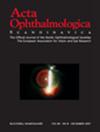Deep Learning for prediction of late recurrence of retinal detachment using preoperative and postoperative ultra-wide field imaging
Abstract
Purpose
To elaborate a deep learning (DL) model for automatic prediction of late recurrence (LR) of rhegmatogenous retinal detachment (RRD) using pseudocolor and fundus autofluorescence (AF) ultra-wide field (UWF) images obtained preoperatively and postoperatively.
Materials and Methods
We retrospectively included patients >18 years who underwent either scleral buckling (SB) or pars plana vitrectomy (PPV) for primary or recurrent RRD with a post-operative follow-up >2 years. Records of RRD recurrence between 6 weeks and 2 years after surgery served as a ground truth for the training of the deep learning (DL) models. Four separate DL models were trained to predict LR within the 2 postoperative years (binary outputs) using, respectively, UWF preoperative and postoperative pseudocolor images and UWF preoperative and postoperative AF images.
Results
A total of 412 eyes were included in the study (332 eyes treated with PPV and 80 eyes with SB). The mean follow-up was 4.0 ± 2.1 years. The DL models based on preoperative and postoperative pseudocolor UWF imaging predicted recurrence with 85.6% (sensitivity 86.7%, specificity 85.4%) and 90.2% accuracy (sensitivity 87.0%, specificity 90.8%) in PPV-treated eyes, and 87.0% (sensitivity 86.7%, specificity 87.0%) and 91.1% (sensitivity 88.2%, specificity 91.9%) in SB-treated eyes, respectively. The DL models using preoperative and postoperative AF-UWF imaging predicted recurrence with 87.6% (sensitivity 84.0% and specificity 88.3%) and 91.0% (sensitivity 88.9%, specificity 91.5%) accuracy in PPV eyes, and 86.5% (sensitivity 87.5%; specificity 86.2%) and 90.6% (sensitivity 90.0%, specificity 90.7%) in SB eyes, respectively. Among the risk factors detected with visualisation methods, potential novel ones were extensive laser retinopexy and asymmetric staphyloma.
Conclusions
DL can accurately predict the LR of RRD based on UWF images (especially postoperative ones), which can help refine follow-up strategies. Saliency maps might provide further insight into the dynamics of RRD recurrence.

 求助内容:
求助内容: 应助结果提醒方式:
应助结果提醒方式:


